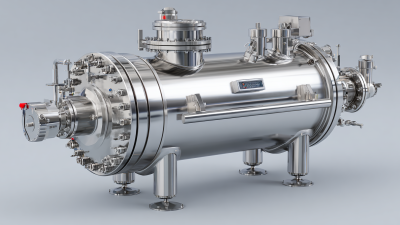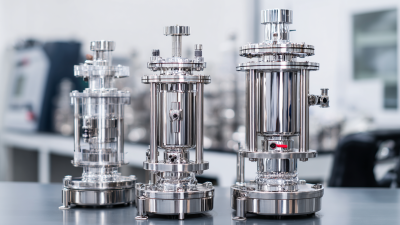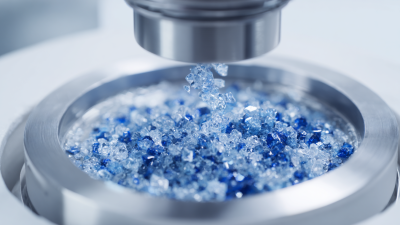You know, since High Pressure Cell Disruptors came onto the scene, they've truly changed the game in modern scientific research. These days, they help us get stuff done faster and more precisely than ever before when it comes to processing materials. I was reading this report from Grand View Research, and apparently, the global microfluidics market is headed to hit around $45.5 billion by 2025 — all thanks to tech advances like high-pressure homogenization.

CAS PETER (HANGZHOU) NANOTECHNOLOGY CO., LTD is really leading the charge here, focusing on developing and selling high-pressure homogenizers and microfluidizers. They’re super dedicated to creating nanotech solutions that fit a bunch of different industries’ needs. Honestly, they understand how crucial High Pressure Cell Disruptors are for pushing scientific breakthroughs. By harnessing these tools, researchers are making huge strides—whether it’s breaking open cells, making emulsions, or shrinking particle sizes. All of this is moving fields like biotech, pharma, and materials science forward at a pretty rapid pace.
High pressure cell disruptors have really become essential tools in today’s scientific world. They make it so much easier to extract important cellular components and improve the quality of biological samples. Basically, these devices work by applying super high pressures, which helps researchers break down cell walls more effectively — and that’s a game-changer for biotech and pharma applications. I read somewhere that according to MarketsandMarkets, the global market for cell disruption is expected to hit around USD 541 million by 2025. That just shows how much demand there’s been for better sample prep techniques.
CAS PETER (HANGZHOU) NANOTECHNOLOGY CO., LTD is doing some pretty cool stuff in this space. They’re focusing on advanced high pressure homogenizers and microfluidizers, aiming to meet the growing needs across different industries. Thanks to innovative nanotechnology, they’re supporting various sectors like pharma and food & beverage, where precise homogenization isn’t just a luxury — it’s a must. They’re really dedicated to helping researchers get better results by providing equipment that’s both efficient and reliable. As more people look for top-notch extracts and formulations, the importance of high pressure cell disruptors only keeps growing — driving science and discovery forward like never before.
High pressure cell disruptors have really become a game-changer in modern research. They boost the efficiency of breaking open cells like nothing else. Basically, by applying high pressure, these tools can rupture cell walls effectively, releasing all those inside goodies—like proteins and enzymes—without messing up their structure. It’s pretty awesome because not only does this increase the amount of what we’re after, but it also cuts down on the time you need to do the job. No kidding, high pressure is now a big deal in biotech and pharma fields.
What’s more, the fact that they cause rapid cell lysis means scientists can grab valuable stuff—like delicate proteins—with minimal damage. This becomes super important when dealing with sensitive samples that need to be handled carefully. Honestly, these high pressure disruptors are changing the game in cell biology research. They make experiments quicker, more efficient, and open up new possibilities for discovering what’s inside cells. Thanks to these innovative methods, researchers are pushing further than ever before, exploring cellular materials in ways we only dreamed of before.
| Technique | Pressure Range (MPa) | Cell Disruption Efficiency (%) | Sample Types | Applications |
|---|---|---|---|---|
| Hydraulic Homogenization | 10-150 | 85 | Bacterial cells | Protein extraction, enzyme production |
| Ultrasonic Cell Disruption | 5-100 | 90 | Yeast and fungi | Metabolite analysis, genomic study |
| Ball Mill Disruption | 1-50 | 75 | Plant tissues | Secondary metabolite extraction |
| Cryo-Pressing | 100-400 | 95 | Animal cells | Vaccine development, therapeutic protein purification |
| French Press | 15-30 | 80 | Microbial cells | Biotechnology, industrial enzymes |
High pressure cell disruptors are really a game-changer in the world of breaking open cells. They actually beat out the old-school methods like sonication, bead milling, or chemical lysis in a lot of ways. For one, they’re super efficient at lysing cells—you get complete disruption with less starting material, which is great because it helps keep delicate biomolecules like proteins intact. That’s a huge deal if you’re planning to do stuff like protein purification or analysis later on. On the flip side, traditional techniques often use harsher conditions that can mess up proteins or other cell components, which can end up messing with your results.
Plus, high pressure disruptors tend to be more scalable and easier to automate. That means you can process more samples faster, which is a huge plus in busy labs or high-throughput settings. Compared to old methods, which can be pretty labor-intensive and slow, these systems allow for quick and efficient sample prep. They also tend to use less energy overall and produce less heat, lowering the chance of thermal damage—so your samples stay healthier. As research keeps pushing for bigger, better, and more reliable biological materials, high pressure cell disruptors are really becoming the go-to choice. They’re changing the game when it comes to making cell disruption faster, cleaner, and just overall more effective.
High pressure technology has really been making waves in the biotech and pharma worlds lately, opening up totally new ways for scientists to make discoveries. For example, high pressure cell disruptors are now pretty much essential when it comes to extracting biomolecules—they help boost both the amount and purity of the key compounds we need. I remember reading in 'Biotechnology Advances' that using high-pressure methods can increase protein extraction efficiency by as much as 70%, which is a big deal compared to the old-school techniques. This level of improvement is especially important when developing biopharmaceuticals, since they often depend on complex proteins and enzymes.
But it's not just about breaking open cells—high pressure tech is also super useful when it comes to creating drug formulations. According to a market research report from Grand View Research, the global high pressure processing (HPP) market in the food and drink sector is expected to hit around USD 1.4 billion by 2025. That’s a clear sign that people are really recognizing how effective HPP can be. In pharma, this tech helps make drugs more stable and boosts how well they work inside the body, leading to better treatments overall. As scientists keep exploring all the ways high pressure can be applied to biotech and pharmaceuticals, the potential for breakthrough discoveries just keeps growing. It’s an exciting time, with a lot of hope for new advancements that could have a real impact on public health and safety.

Lately, there’ve been some pretty exciting breakthroughs in high-pressure cell disruption tech, and honestly, it’s really changing the game for research across all kinds of scientific fields. Innovations like cold atmospheric pressure plasma and ultrasonication—especially when combined with high-pressure methods—are giving scientists new tools to better break down cells. These techniques not only boost the amount of stuff like proteins and genetic material you can extract but also help keep those molecules functional and intact. That means results are more reliable, and the experiments just tend to go smoother.

And it doesn’t stop there. Automation and machine learning? They’re set to totally transform how we do this kind of work. Imagine systems with sensors that can automatically tweak pressure levels and timing on the fly, customizing the process for different cell types and what you’re after. Plus, with machine learning crunching huge amounts of data, researchers can spot patterns and optimize extraction methods way faster than before. As these techs keep improving, I really believe they’ll open up totally new possibilities for scientists, making workflows more efficient and helping us answer even the most complicated biological questions with much greater accuracy.
High pressure cell disruptors have really changed the game in scientific research, making it possible to achieve breakthroughs across a bunch of different fields. There are quite a few case studies out there that show just how important these tools are in helping us understand biological systems better. For example, a study published in the Journal of Biological Chemistry pointed out that using high pressure techniques can boost protein yields by as much as 300%, which really ramps up the efficiency of extracting enzymes. Another interesting piece of research from the National Institutes of Health showed that applying high pressure during cell lysis allowed scientists to successfully recover nucleic acids with over 95% purity—way better than the traditional methods.
When you're working with high pressure methods, it’s usually best to fine-tune the pressure settings to match your specific samples. A good tip is to gradually increase the pressure and keep an eye on how quickly the cells are breaking open—it helps you find that sweet spot for each experiment. Also, using a temperature-controlled setup can help prevent heat from damaging the samples, which is pretty important for keeping things intact.
Overall, adding these high pressure techniques into your research toolkit can really push forward our understanding of biochemistry. It's a good idea for researchers to stay up-to-date with the latest tech and methods, since the field is changing pretty fast. No doubt, high pressure methods are not just about making breakthroughs—they're actually about redefining how we do research today.
: High pressure cell disruptors are vital tools that apply extreme pressures to break down cell walls, enabling the extraction of valuable cellular components and enhancing the quality of biological samples. They are essential for various applications in biotechnology and pharmaceuticals.
According to a report by MarketsandMarkets, the global cell disruption market is projected to reach USD 541 million by 2025, reflecting a growing demand for efficient sample preparation techniques.
They enhance efficiency by applying high pressure to break down cell walls effectively, increasing the yield of target compounds and significantly reducing processing time, crucial for fields like biotechnology and pharmaceuticals.
They offer higher efficiency in cell lysis, preserving the integrity of sensitive biomolecules, and require less input material. Traditional methods often compromise the quality of research outcomes due to harsher conditions.
High pressure techniques induce rapid cell lysis with minimal degradation of valuable materials such as enzymes and proteins, making them ideal for sensitive biological samples that require careful handling.
Yes, high pressure cell disruption techniques are typically more scalable and can be automated, allowing for greater throughput in research settings compared to traditional methods, which are often labor-intensive.
High pressure methods generally require less energy and produce less heat, reducing the risk of thermal damage to samples compared to traditional methods that may generate higher temperatures during processing.
High pressure cell disruptors cater to a range of industries including pharmaceuticals, food and beverage, and other sectors where precise homogenization and efficient extraction are crucial.
By providing innovative equipment that ensures high efficiency and reproducibility in cell disruption processes, high pressure cell disruptors enhance research outcomes and foster advancements in scientific discovery.
High pressure cell disruptors allow researchers to explore the vast potential of cellular materials more efficiently, pushing the boundaries of achievable results in laboratory settings.
High pressure cell disruptors are honestly game-changers in today’s scientific world. They bring innovative ways to break open cells that really boost efficiency compared to old-school methods. When you apply lots of pressure, these devices can unlock cellular components more effectively, which is why they’re so vital in biotech and pharma fields. If you compare them to traditional techniques, it’s clear—they often lead to better yields and quicker results. It’s pretty impressive how much they’ve improved the research game.
And if you look at actual case studies, plenty of breakthroughs have been made using high pressure disruptors—proof of just how valuable they are. Looking ahead, the tech is only getting better, promising to shake up the field even more and open doors to new applications, especially in nanotech. Over at CAS PETER (HANGZHOU) NANOTECHNOLOGY CO., LTD, we’re all about pushing the boundaries of high pressure homogenization because we want to help industries harness these groundbreaking tools for their own innovations.







